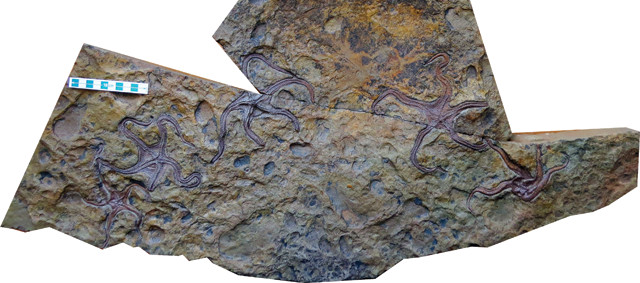
by Sarah Derouin Thursday, December 14, 2017

Fossils of roughly 275-million-year-old brittle stars were found in Western Australia. Credit: Kenneth McNamara.
Threats to species can encourage evolution, leading to animals with harder shells or other defensive adaptations. In a recent study in the Journal of Systematic Palaeontology, researchers found that while some ancient brittle stars — relatives of starfish with long, whip-like arms — evolved in the face of threats, some adapted a different approach: they moved.
In Western Australia, scientists discovered a “meadow” of fossilized Permian-aged brittle stars containing several well-preserved specimens, including a new genus and species called Teleosaster creasyi. Considered an “archaic” species, T. creasyi is the last-known brittle star that shares its basic morphology with those that first appeared in the Ordovician, 200 million years earlier.
Archaic brittle stars were relatively easy prey. And as new predators evolved through the Paleozoic, especially early forms of rays and crabs that could crunch through hard shells, modern lineages of brittle stars emerged that thrived in warmer waters closer to the equator. “The threat from predation is an underappreciated driver of evolutionary change,” said study co-author Kenneth McNamara of the University of Cambridge in England in a statement. “As more predators began to appear, the brittle stars started to evolve more flexible bodies, which enabled them to either burrow into the sediment, or to move more rapidly to escape.”
Other brittle stars — including some archaic lineages, as the new T. creasyi find attests — simply moved to the colder, predator-free waters around Australia, which was adjacent to Antarctica and nearer to the South Pole during the Paleozoic. Living in a place with low predation allowed these brittle stars to grow larger, and persist even long after the Permian-Triassic extinction event roughly 252 million years ago. Meadows of living brittle stars can be seen around Antarctica today.
© 2008-2021. All rights reserved. Any copying, redistribution or retransmission of any of the contents of this service without the expressed written permission of the American Geosciences Institute is expressly prohibited. Click here for all copyright requests.